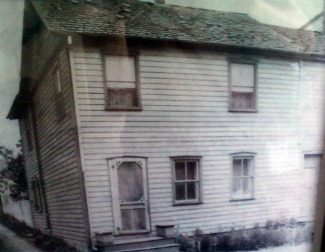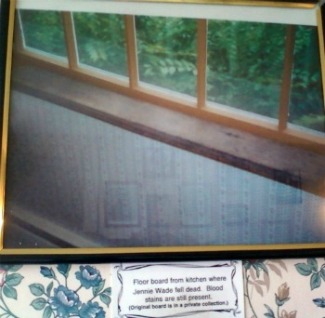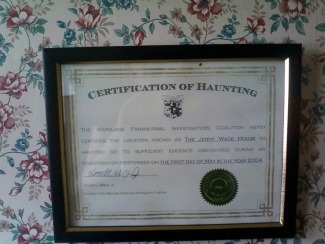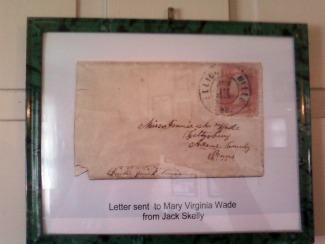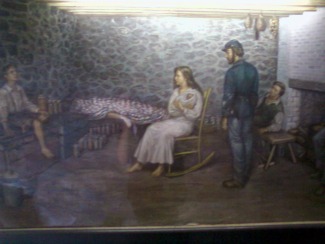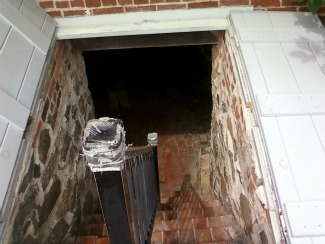A Tragic Love Story
by Katie Triplett
A tragic story of two star-crossed young lovers, who never got to be together, brings about a legend for romantic hopefuls. During the battle of Gettysburg, there was a young woman named Jennie Wade, who was shot and killed in her kitchen while kneading dough for biscuits. A stray bullet from a sharpshooter had come through the kitchen door, and pierced her heart killing her instantly. Found in Jennie’s apron pocket, was a picture of her sweetheart, 22-year-old Jack Skelly.
The tragedy in this love story lies in the fact that Jennie and Jack never got to be together in life. Jack Skelly was wounded in battle on June 15, 1863, at Carter's Woods where he later died in Winchester, Va. on July 12, 1863 due to his wounds. Jennie died on the morning of July 3, 1863, just nine days before her sweetheart died.
Legend has it, as it's written on a plaque hung from the door that the stray bullet pierced before it struck and killed Jennie Wade:
“Legend has it that if an unmarried girl puts her ring finger through the bullet hole in this door, she will receive a proposal of marriage within a year. You’re not superstitious? Neither were some others, but it has happened...we get letters.”
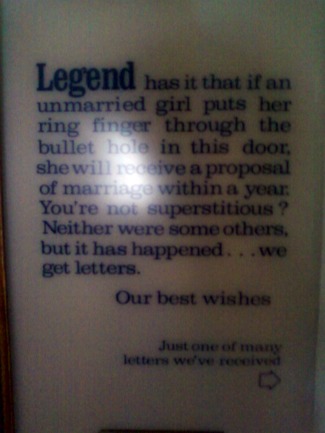
According to Sweet Designs Magazine's article titled, "Ghost Story, or Love Story," three bridesmaids were attending a local wedding in Gettysburg. Each of the single women, tried their hand at luck, and stuck their ring finger in the bullet hole. Surprisingly, all three women ended up getting engaged within the year.
Another young woman toured the Jennie Wade house with her boyfriend, and when she placed her finger in the hole, she turned around to find her boyfriend down on one knee with a diamond ring for her.
Another lady who toured the Jennie Wade House, Angela Korbel, posted on the Gettysburg Battlefield Tours Website:
"When I participated in your tour of the Jennie Wade House and heard about the legend that if a single female inserts her ring finger through the hole in the parlor door she would receive a marriage proposal within the year, I was highly skeptical….However, I cannot deny the fact that apparently, there might be some truth to it.”
“I attended the tour in June 2010. My mother convinced me to stick my ring finger through the hole in the parlor door after hearing about the legend. I reluctantly did so just to make her stop harassing me. Well who would have thought that 6 months later (Christmas Day to be exact) my boyfriend would propose!”
Posted to the fateful door which was struck by the stray bullet, is a letter from a woman who was touring Gettysburg with a Girl Scout troop and gave the legend a whirl by trying it out for her, she was engaged and married within a year just like the legend said. Her wedding picture and letter are framed and posted for tourists and all to see.

According to Meyers, many women come every year to put their ring finger in the bullet hole. Emails and letters from woman who have actually tried doing it and have gotten married or engaged have been received too, Myers explains. Maybe the legend lies in the fact that the bullet came through the very door the legend is attached too, and went through her heart.
"A lot of reason why I think people have the legend here on the door is because this is the last door it [the bullet] went through before it struck Jenny and killed her," Myers said.
Speculation of a romance between Jennie Wade and Jack Skelly has been brewing for years. The two childhood friends grew up together in Gettysburg Pennsylvania prior to the start of the Civil War. According to the Pittsburgh Gazette Times in a November 9, 1913 article, Jack Skelly's family found out about Jack and Jennie's plans to marry after his death. Jennie's mother also didn't know of her daughter's intentions to wed till after her daughter’s death.
According to Jack Skelly's family, he was planning on marrying Jennie Wade when he got his furlough in the fall, but unfortunately Jack died during battle in Winchester, Va. According to sources at the Adams County Historical Society, Jennie and Jack were engaged in the spring of 1863 and were to be married in September of 1863 if Jack could secure his furlough.
Also in the Pittsburgh Gazette Times, a friend of Jack Skelly, stated that him and the men in Jack's company knew that Jack wrote back and forth with the young Jennie Wade, but "did not know of their engagement and intended marriage."
The rumor of there being a picture of Jack Skelly found in Jennie’s apron pocket when she was shot and killed, turned out to be true. In fact, according to the Adams County Historical Society, she was found with his photo in her dress pocket at the time of death.
"A lot of people say if Jack would have gotten out and Jenny would have survived they would have ended up getting married,” Myers said.
The sad part is, neither one of them knew of the others tragic death. Jack Skelly's childhood friend, Wesley Culp, was supposed to have delivered a message to Jennie from Jack. Unfortunately, Wesley Culp was killed in battle, and the message went undelivered.
How Jennie Wade Died
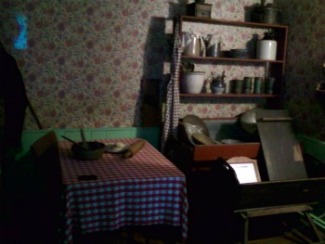
One that tragic morning, like every other morning, Jennie Wade woke up early and began preparing biscuits for the soldiers in her sister's kitchen. An infantryman, possibly from Louisiana or maybe a Union marksman, set posted from an occupied house somewhere on the other side of Baltimore Street further up north, fired off shots. One of those shots in particular, passed through the outside kitchen door of Georgia McClellan's home, went through the door between the kitchen and the parlor, and struck Jennie wade in the back left shoulder blade piercing her heart and killing her instantly.
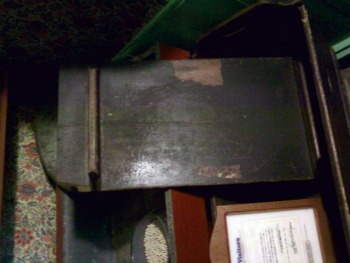
At this time, Jennie's sister Georgia screamed at the top of her lungs upon hearing their mother say that Jennie was dead. Federal Soldiers ran into the house from all directions to see what was wrong. The soldiers instructed that the ladies go immediately into the cellar on the other side of the house where it would be safer. However, actually getting to the cellar posed a problem.
Jennie's mother refused to leave her daughter's body behind. So the soldiers wrapped Jennie's lifeless body in a quilt that her sister made, and proceeded to carry her up the stairs. Mary Ann Wade, followed by her children, made their way up the stairs to the bedrooms, followed by the soldiers who were carrying her daughter's body.
Everyone then climbed through the hole that had been blown into the wall from the shell the day before. The hole was made larger by the soldier's who kicked it open wider to fit Jennie's body through. Everyone made their way down the other flight of steps on the opposite side of the house, and out the kitchen door of Georgia's neighbor's house.
Once outside, the group made their way into the cellar where they would spend the remainder of the day and night until the battle was over. Jennie's lifeless body was placed on a wooden bench in the back left corner of the basement. For the next 18 hours, Jennie's family and the Federal soldiers sat and waited for the battle outside to subside.
When the battle was finally over with, Jennie's body was placed in a wooden casket that had been prepared for a soldier, and was laid to rest in the garden behind her sister’s house for the next six months, until it was later moved to the cemetery nearby the German Reformed Church. Nearly two years after the Battle of Gettysburg, Jennie's sister, Georgia, her husband Louis, and the oldest brother, John, moved Jennie's body to the Evergreen Cemetery.
Jennie's Memorial Most Visited in Evergreen Cemetery
After her sister's death, Georgia McClellan became a nurse, aiding wounded soldiers. She and her husband Louis eventually moved out west to Iowa, where she continued to practice being a nurse. In Iowa, Georgia became the president of the Iowa Woman's Relief Corps.
The group decided to dedicate a monument and have it erected for Georgia's sister, Jennie Wade in the Evergreen Cemetery in Gettysburg, Pa. Since Iowa was the only state where there were no regiments in the Battle of Gettysburg, there was no Iowa state monument. The monument, replacing Jennie's original headstone, was erected on August 17, 1900, and later dedicated to Jennie on September 16, 1901. To this day, a flag dedicated by the Iowa Woman's Relief Corps, flies over Jennie's grave 24/7.
Brian Kennell, has been the superintendent of the Evergreen Cemetery for almost 20 years. He said that research has been done to find out the act of congress that allows a flag to fly all day and night, but there is no proof. However, there is a provision in flag code that allows flags to be flown 24/7 for patriot services.
"Her gravesite is the most visited in Evergreen," said Brian Kennell, Superintendent of the Evergreen Cemetery in Gettysburg.
The Iowa Woman's Relief Corps requested that a bronze plaque is to be placed at the base of Jennie's monument that reads her full Christina name: Mary Virginia Wade.
Family and friends called her, "Ginnie," Kennell explains, so she eventually just became known as "Jennie." A beautiful statue stands atop of Jennie's monument, with the American flag flying to the right of it. You can see her flag flying from the archway as one enters the Evergreen Cemetery.
